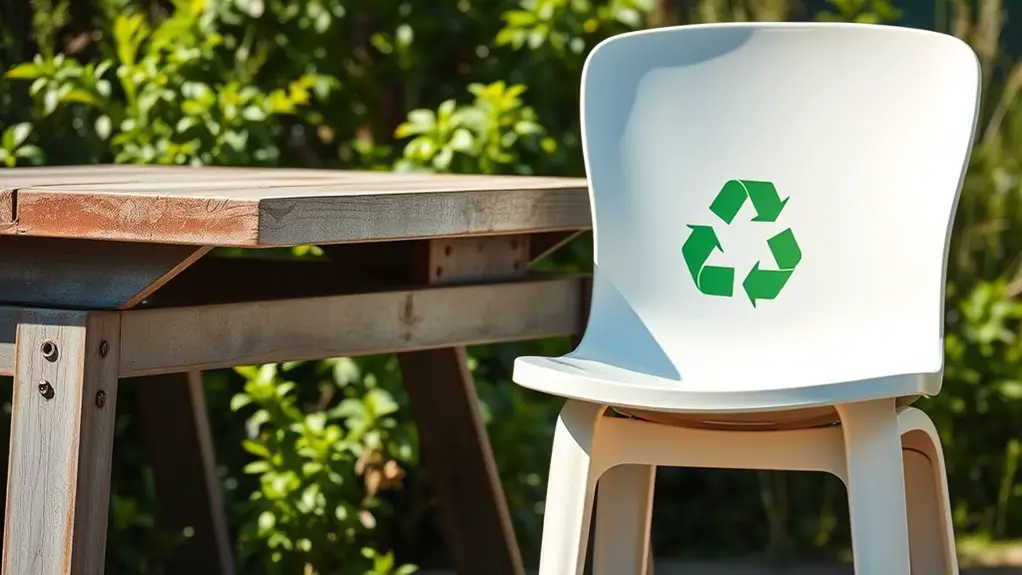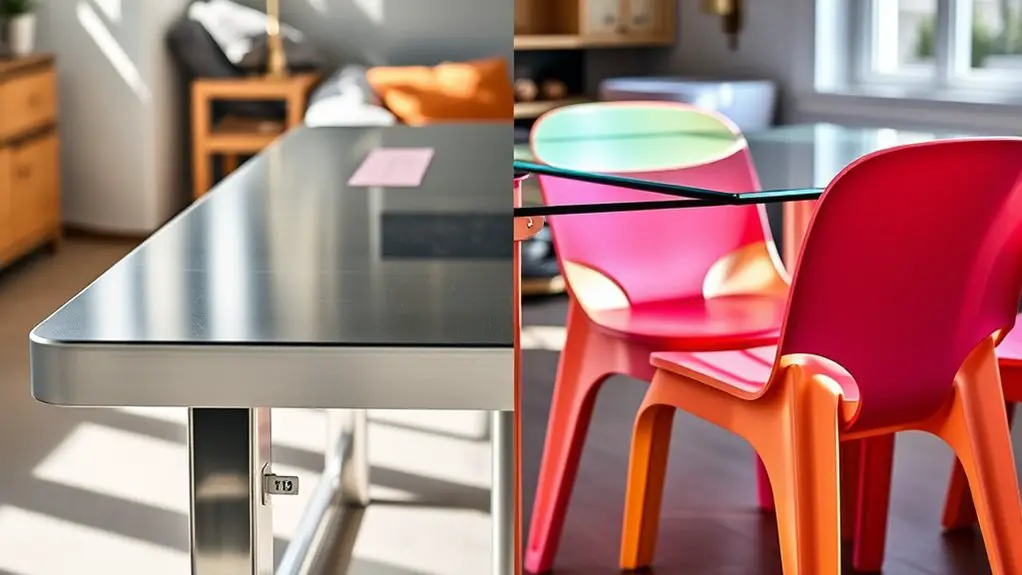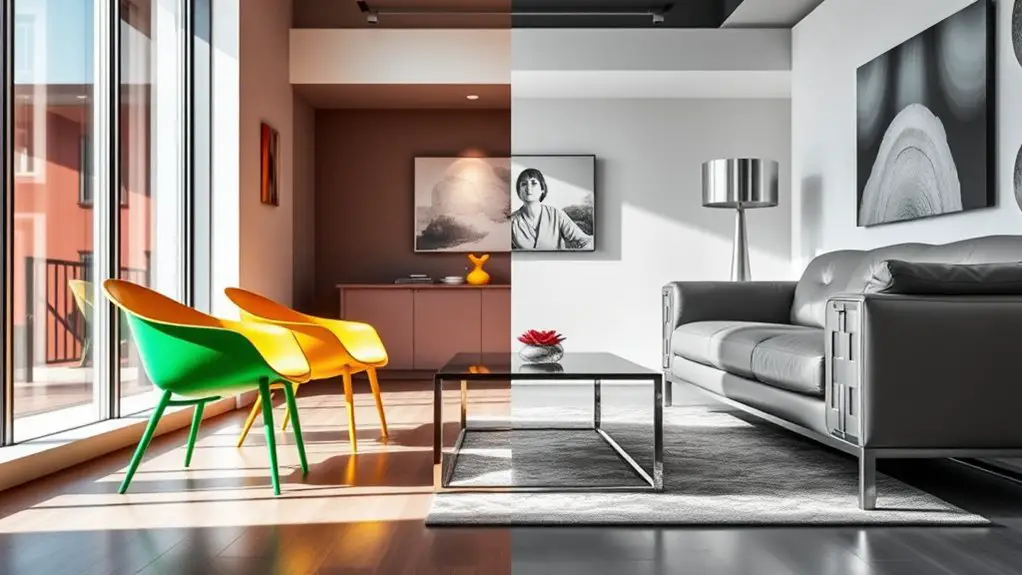When deciding between plastic and metal furniture, consider your specific needs. Metal is more durable, resistant to extreme weather, and can support significant weights, making it perfect for heavy use. While it requires some upkeep, the long-term value is worth it. Plastic, on the other hand, is lighter, easier to move, and has lower initial costs. However, it tends to fade and can't withstand heavy use as well as metal. If sustainability is important, recycled plastic options are eco-friendly. Explore more characteristics and tips to find the right fit for your space and lifestyle.
Key Takeaways
- Metal furniture provides superior durability and strength, making it ideal for heavy use and outdoor conditions.
- Plastic furniture is more affordable and requires minimal maintenance, making it suitable for casual settings.
- Metal offers a sleek, modern aesthetic with diverse design options compared to the often basic appearance of plastic furniture.
- Recycled plastic furniture is environmentally friendly, reducing waste and energy consumption, while metal production has a higher ecological impact.
- Consider long-term value; metal furniture may have a higher initial cost but often proves more cost-effective over time.
Durability and Strength Comparison
When comparing the durability and strength of plastic and metal furniture, you'll find that metal consistently outperforms plastic in most aspects.
Metal furniture, particularly aluminum and stainless steel, boasts high durability that can withstand heavy use without compromising integrity. Its resistance to rust and corrosion ensures a long lifespan, making it ideal for outdoor spaces where weather can be unpredictable. Additionally, aluminum is lightweight and rust-free, making it easier to move around while still being durable.
Metal furniture's sturdiness allows it to support significant weights and endure harsh conditions, including extreme heat and hail. Furthermore, metal furniture is more likely to be made from recycled materials, which reduces resource demand and supports a circular economy.
In contrast, while plastic furniture is generally durable, it can become brittle and crack over time, especially in colder climates.
You might notice that plastic fades in color with prolonged sun exposure, which can detract from its appearance. Moreover, plastic furniture tends to have a shorter lifespan under heavy use compared to metal.
Its lightweight nature makes it less sturdy, signifying that it's not the best choice for high-traffic areas.
Ultimately, if you're seeking furniture that can endure wear and tear, metal stands out as the superior option.
The exceptional strength and durability of metal furniture make it a practical choice for both residential and commercial settings.
Maintenance and Care Needs
Maintaining plastic and metal furniture involves different care needs that can significantly impact their longevity. For plastic furniture, you can easily clean it with a soft brush or cloth. A mild soap solution works wonders for tougher stains, but avoid abrasive cleaners to prevent scratches. During winter, store your plastic items indoors or cover them to protect against extreme conditions. If mildew appears, use a soapy water solution or a white vinegar mix for cleaning. Additionally, plastic furniture is often lightweight and easy to move, making it a convenient option for outdoor spaces.
On the other hand, metal furniture requires a bit more attention. Regular cleaning with a soft cloth and mild soap will help maintain its appearance. To prevent rust, consider applying rust-resistant paint or coatings. Inspect your metal furniture for signs of damage regularly and clean it after outdoor use.
Here's a quick comparison of maintenance needs:
| Furniture Type | Cleaning Method | Protective Measures |
|---|---|---|
| Plastic | Soft cloth/brush, mild soap | Store indoors in winter |
| Metal | Soft cloth, mild soap | Rust-resistant coatings |
| Avoid extreme conditions |
| | | Clean after outdoor use
Environmental Considerations

Sustainability is a crucial factor to consider when choosing between plastic and metal furniture. Both materials have distinct environmental impacts that can influence your decision. Here are some key points to keep in mind:
- Energy Consumption: Recycled plastic furniture uses about 70% less energy than new plastic, while metal production is energy-intensive due to resource extraction.
- Resource Conservation: Utilizing recycled plastics reduces the need for new materials and helps keep waste out of landfills and oceans. Conversely, metal and virgin plastic extraction can harm ecosystems.
- Carbon Emissions: Switching to recycled plastic can cut CO2 emissions by up to 43%. In contrast, metal production contributes significantly to greenhouse gas emissions.
- Waste Reduction: Recycled plastic furniture helps manage plastic waste effectively, while metal can corrode, requiring treatments that may generate more waste.
Aesthetic and Design Factors
Choosing between plastic and metal furniture also involves considering aesthetic and design factors. Plastic furniture often lacks the elegance found in other materials, though some designs attempt to mimic wood or metal.
In contrast, metal furniture offers a sleek, modern look that can elevate any space. The malleability of metal allows for diverse, unique shapes, making it ideal for one-of-a-kind designs, while plastic furniture generally sticks to simple, lightweight designs.
When it comes to style preferences, metal furniture suits those who appreciate unique, upscale items and want a focal point in their room. Its versatility means it can fit various design aesthetics, from modern to industrial, with a broad range of finishes available. Additionally, metal furniture is often chosen due to its improved durability compared to plastic alternatives, which can crack and fade over time.
On the other hand, plastic furniture is more suited for casual, everyday use, such as picnics, lacking the aesthetic variety of metal designs.
Additionally, metal furniture can frame the human figure in visually pleasing ways, adding a sophisticated touch. If you're aiming for a contemporary feel in both indoor and outdoor spaces, metal furniture is a standout choice that aligns well with modern design principles.
Cost and Practicality Analysis

When considering cost and practicality, you might find that plastic furniture has an appealing edge due to its lower initial prices and lightweight nature. Typically, you can grab a plastic chair for around $20-$30, making it budget-friendly. However, while plastic furniture is cheaper upfront, it might require more frequent replacements, which can add up over time.
Here's a quick breakdown of the cost and practicality aspects:
- Weight: Plastic furniture is lightweight and easy to move, perfect for rearranging spaces.
- Maintenance: Minimal upkeep is needed for plastic; just a quick wipe-down will do.
- Durability: Metal furniture is sturdier and lasts longer, providing better long-term value despite higher initial costs. Additionally, metal furniture typically lasts longer than plastic options, making it a better investment for long-lasting durability.
- Storage: Foldable plastic options save space, unlike bulkier metal furniture.
Ultimately, if you prioritize initial savings and ease of movement, plastic might suit you better. However, if you're willing to invest more upfront for durability and longevity, metal furniture could offer the better return in the long run.
Frequently Asked Questions
Can Plastic Furniture Withstand Extreme Temperatures?
Yes, plastic furniture can withstand extreme temperatures. It maintains its strength in both hot and cold conditions, so you won't have to worry about it becoming brittle or deforming, making it suitable for year-round use.
Is Metal Furniture Customizable for Different Designs?
Yes, metal furniture's highly customizable. You can work closely with designers to create pieces that fit your space, style, and needs, incorporating unique textures, finishes, and detailing to match any interior theme you desire.
How Does Plastic Furniture Handle UV Exposure?
Plastic furniture handles UV exposure well if made from UV-resistant materials like HDPE or PP. These plastics resist fading and degradation, maintaining their color and strength even after prolonged sun exposure, ensuring durability for outdoor use.
Are There Any Health Risks Associated With Plastic Furniture?
Yes, there are health risks associated with plastic furniture. You could be exposed to harmful chemicals and microplastics, which may lead to reproductive issues, respiratory problems, and other serious health conditions over time.
What Types of Finishes Are Available for Metal Furniture?
When considering metal furniture finishes, you've got options like brushed, polished, powder-coated, antiqued, blackened, hammered, and satin. Each offers unique aesthetics and durability, ensuring you find the perfect match for your style.

